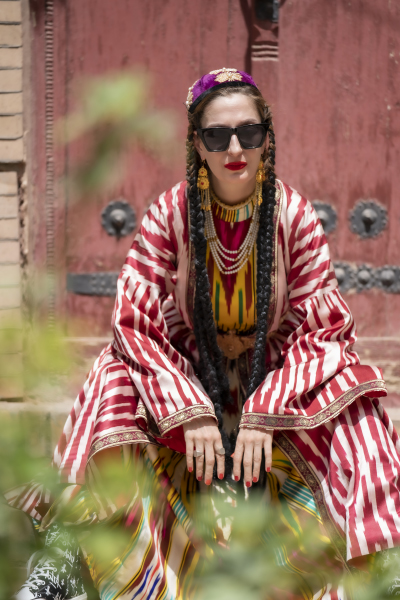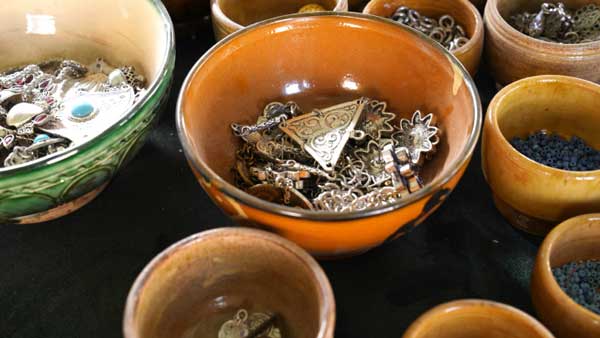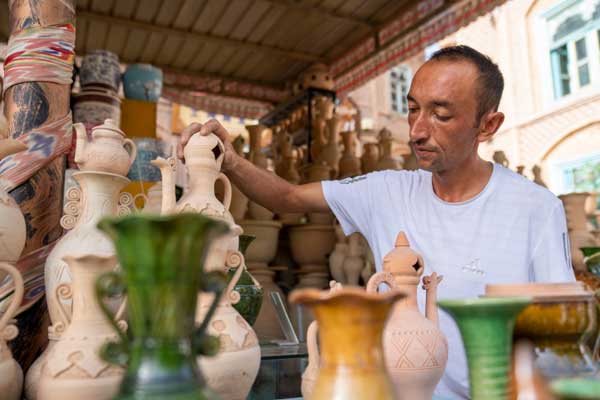South Xinjiang preserves traditional culture through fashionable means
Heavenly lakes as blue as the wings of a mythical halcyon bird, the smells of roasting meat penetrating the night air, exuberant embroidery decorating furnishings and hemlines… Welcome to Xinjiang Uygur Autonomous Region.
Speaking of hemlines… China's ethnic fashions are diverse and comprise everything from hard-to-handle fabrics to fantastical embroidery to fantastical earrings.
Traditionally, the textiles, techniques and accessories are used to preserve some of the histories of China's 56 ethnic groups, some of which never used a written language to document their stories. Today, they are a source of treasured inspiration. And preservation.
Fashion inspired by local culture references can be a starting point for understanding how a wardrobe, as a dynamic part of contemporary life, can represent and maintain local traditions, including those of the Uygur population.

Charting the region
The Uygurs are Xinjiang's largest ethnic group. More than 11.6 million Uygur were living in the region, accounting for 44.96 percent of the local population, according to the seventh national census in 2020.
Kashgar, or Kashi in standard Chinese, is an oasis city in the Tarim Basin region of south Xinjiang. It is one of the westernmost cities of China, near the borders with Afghanistan, Kyrgyzstan, Tajikistan and Pakistan. The area has served as a trading post and strategically important city on the ancient Silk Road running between China, the Middle East and Europe for more than millennia, resulting in an eclectic mix of cultures and religions.
Speaking of the Silk Road, here's a Xinjiang fashion fact: Under the project Silk Road Fashion: Clothes as a Means of Communication in the First Millennium B.C., Eastern Central Asia, a Chinese-German joint research group has been investigating garments excavated from Xinjiang to gain a deeper understanding of social structures, resource availability, economic history, and trade routes back in the day. Interest in the project intensified with its 2014 discovery of the world's oldest known pair of pants. But we'll circle back to those.
Once you pass through the gigantic gates of Kashgar's Ancient City, now a hot tourist destination, you are met with the sight of radiantly painted shops and their gleaming merchandise adorning the streets. But what caught the eye of this author, was the Atlas store and weaving atelier housed inside a renovated wood-framed building with all its three stories dressed to the nines in... silk.
Now, yours truly has a soft spot for the large handwoven Atlas silk squares emblazoned with wildly colorful flowery motifs produced in the area."Atlas" is in fact a traditionally handwoven pattern on silk, with the name being derived from the Atlas moth, the larva of which produces the silk. Worn by Uygur men and women, the fabric embodies their knowledge andhistory, establishing a connection to their vibrant past and hopes for a bright future. Which brings us to Xinjiang fashion fact number 2: In May 2006, the weaving technique that produces the unique Atlas patterns made it onto China's National List of Intangible Cultural Heritage. Now you know.

Capturing tradition
Within the ancient walls of Kashgar, sauntering through the narrow, winding streets brimming with small stalls serving up local culinary delights, another "phenomenon" caught the eye: People dolled up from head to toe in local dress having their pictures taken professionally at the historical venues sprinkled throughout the area. These ubiquitous concept shoots immediately reminded this author of their peers across China, wearing hanfu inside, for example, Beijing's former imperial palace, known as the Forbidden City in the Ming and Qing dynasties (1368-1911).
Hanfu, meaning Han Chinese dress, is based on the age-old fashion traditions of the largest of all 56 ethnic groups in China: the Han (covering some 92 percent of the population). With the help of social media, a hanfu revival movement has emerged out of a desire to express national identity and the growing confidence of Chinese youths to express themselves. In the past couple of years, young Chinese have elevated the dress code from a niche hobby to a generation's tool of cultural expression, while transforming it into a passionate consumer market. A question beckons: Does the same "logic" apply in Kashgar?
Twenty-something Uygur designer Mawlan Turaq runs a photography and fashion studio specialized in taking traditional Uygur-inspired portraits at locations around the ancient city."For many fervid fans, wearing traditional dress is a nod to their cultural identity and symbolizes their inspiration to delve deeper into that heritage," Mawlan told Beijing Review."And today, dressing up in local Uygur garments—the Uygur wardrobe slightly differs from town to town—has become the hot tourist thing to do here." But this is not as superficial as it may sound."It's all about a beautiful, tangible experience for them, getting acquainted with styles they'd otherwise never know and taking home the memories, spreading the word to others who, like them, probably don't know too much about our customs and clothing," he added.
Many Chinese designers have incorporated hanfu elements into their collections in the past few years. Mawlan now potentially stands at the forefront of a new wave of fashionable pioneers, weaving his ancestry through the clothes and accessories he designs and sells inside the studio.
"Clients, mostly tourists, usually make an appointment to do a traditionally styled concept shoot—a three-hour experience which will set you back roughly 1,900 yuan ($282) and includes clothing, hair, makeup and photography," Mawlan explained, adding that many who originally come in for the experience, will eventually leave having bought one or more pieces of clothing or jewelry.
This is the business of fashion. But what does it actually look like?
Traditional Uygur dress is deeply intertwined with the ethnic group's history as traders along the ancient Silk Road. In particular, two pieces of clothing have become symbolic: the chapan and the doppa. The chapan, a play on the caftan, is a long coat that is worn over the clothes during the winter months. It is typically worn by men and comes in a variety of colors, from muted blues to fiery reds. Intricate patterns are embroidered on the exterior and, instead of buttons, the chapan is bound by a large cloth band around the waist.
"Women wear exquisitely embroidered long-sleeved dresses that billow out at the waist. Golds, reds and blacks are the most classic yet still most prevalent color combinations," Mawlan said. Brighter colors, like pink and green hues, plus the occasional tie-dye even, first became popular in the 1980s, but it seems today's youth have returned to the typical palettes."To complement their dresses, Uygur women don plenty of jewelry, including large earrings, bracelets, and necklaces, which in times long gone served as indicators of social status and wealth," the designer slash entrepreneur said, adding that the bigger the accessory, the better its wearer is kept safe from harm. Theirs is a story of fashionable opulence.

Caps off to youth
The outfits Mawlan presented and described are the epitome of Kashgar's traditional Uygur wardrobes. But many locals do still wear a toned-down version of this outfit today. And the cap, or doppa, has proven its most resilient component. The history of these hats traces all the way back to the Tang Dynasty (618-907), a time when Kashgar was one of the four key military strongholds in the empire's western regions.
Fast forward to modern times, and the doppa still bops up and down the streets in a myriad of shapes, colors and styles. Traditionally, it was hand-embroidered with naturally dyed silk, and included intricate patterns that revealed details about its wearer: Who are you? What's your hometown? What do you do for a living? How many children do you have? What's your social status? One glimpse at a person's headgear would answer (most of) these questions.
"Grassland green remains the most common shade," Mawlan said, as it symbolizes the Uygur affinity with, reliance on and respect for Mother Nature. The color purple, elaborate embroidery and other embellishments, especially pearls, would signify wealth in days of yore—even in 2022, to some extent. As far as today's younger generations are concerned, the creator added,"The youth may not be wearing these caps on the daily anymore, though some still do—adding their own style through the doppa decorations, but when it comes to any type of festive occasion, they will still go all out—head to toe."
The clothes people wear tell stories of their culture and heritage—things that can't easily be shrugged on and taken off at will. And on that "forever in style" note, we leave you with one final Xinjiang fashion fact: that oldest pair of pants in the world. These 3,200-year-old pants were discovered in 2014 on a Chinese mummy recovered from Xinjiang's Tarim Basin. Speaking of preservation. Their design was as intricate as that of modern-day, factory-fabricated denim jeans, and equally durable. With the help from fashion designers, archaeologists determined that the pants employed multiple weaving techniques to make the wearer comfortable on horseback. The pants correspond with the domestication of horses, a pivotal event in human history that brought Europe and Asia closer together.